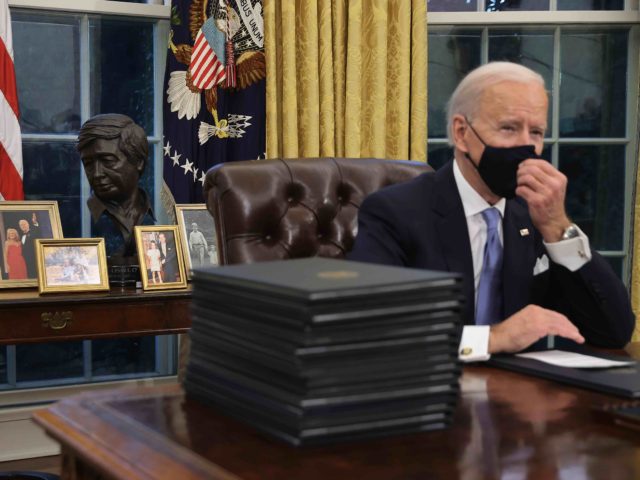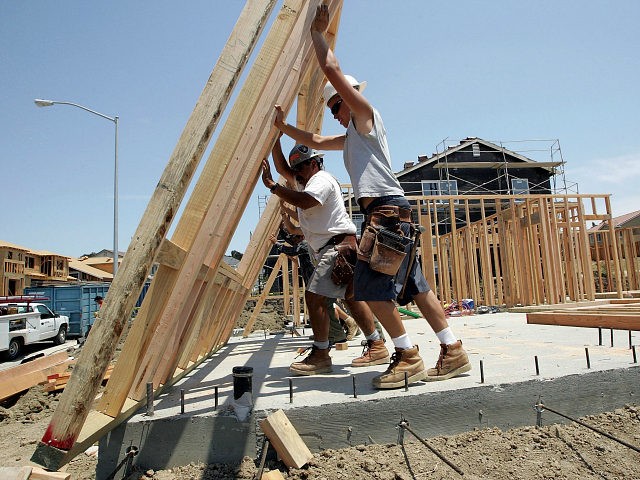Covid Winner: Morgan Stanley Profits Rise 48%

The U.S. economy throttled down in the fourth quarter as the pandemic surged, lockdowns were reimposed, and the country prepared for the presidency of Joe Biden.
Wall Street, however, hit the accelerator. Morgan Stanley said Wednesday that fourth-quarter profits rose 48 percent from a year earlier, highlighting the unevenness of the pandemic’s effect on the U.S. economy.
The storied Wall Street firm made $3.39 billion in the fourth quarter, up from $2.31 billion in the final three months of 2019.
That works out to $1.81 per share, beating the $1.30-per-share profit that analysts had forecast.
Like its primary rival, Goldman Sachs, who also saw a massive profit increase, Morgan Stanley saw a surge of revenue in its core investment banking and trading operations.
Trading revenue rose 32 percent, with both stock and bond trading generating more revenue for the firm. Trading revenues are a huge source of bonuses for Wall Street’s high-flying traders, although they rarely translate into improved stock performance for shareholders.
Investment banking revenues soared 46 percent, mostly due to higher equity underwriting fees. Morgan Stanley has a large business taking companies public, and several large tech firms went public in the last three months of the year. That was a boon for the firm’s underwriting business.
Morgan Stanley’s wealth management arm, which the company grew over the last decade to help the firm find steadier sources of profits instead of the boom-bust cycle of markets, also had a strong quarter. This likely benefited from the huge rally in stock prices that began in late April. Net revenues in this unit were up 24 percent from a year earlier.
–The Associated Press contributed to this repot.
Cesar Chavez’s Great-niece Has No Idea Why Joe Biden Put Bust in Oval Office

Rachel Garcia, the great-niece of farm workers’ union organizer Cesar Chavez, is grateful that President Joe Biden chose a bust of her famous relative to place behind the Resolute desk in the Oval Office — but she has no idea why he did so.
Biden, like President Barack Obama before him, removed a bust of the legendary British Prime Minister Winston Churchill from the Oval Office, a symbol of the special relationship between the United States and Great Britain.
He placed the Chavez bust on the table behind his desk, among portraits of his family members, where it will be seen by anyone meeting with him and will be captured by photographers’ lenses or television cameras in national TV addresses.
Yet Biden has little known association with Chavez. The civil rights leader, who is a prominent hero among many Latinos, is not mentioned once in Biden’s 2007 political memoir, Promises to Keep, which recounted his Senate career to that point.
The San Jose Mercury News reported:
Chavez is among several American leaders Biden has chosen to display in the Oval Office, including a bust of Martin Luther King, a massive portrait of Franklin Roosevelt, a painting of Benjamin Franklin and others.
Garcia said she’d like to meet the president and ask him why he chose to honor Chavez. Though she didn’t get a chance to know him, Garcia met Chavez as a child. She said she remembers the positive energy her great-uncle gave off, and the legacy he left with his family has also left a lasting imprint in her life.
…
On his first day in office, Joe Biden took several far-reaching steps to undo his predecessor’s landmark executive orders restricting immigration to the U.S. In his first day, Biden signed executive orders halting construction of the border wall with Mexico, lifted a ravel ban on people from several Muslim-majority countries and reversed plans to exclude undocumented people from the 2020 census.
Biden has alo promised to work to preserve the Deferred Action for Childhood Arrivals act, a program started in 2012 shielding hundreds of thousands of people who came to the US as kids from being deported.
Biden performed unusually poorly with Hispanic voters in the 2020 presidential election, losing them first to rival Sen. Bernie Sanders (I-VT) in the primary, and then by underperforming among Latinos against Trump in the general election.
The U.S. Navy named a ship for Chavez, a veteran, in 2012. Notably, Chavez opposed illegal immigration, seeing it as a threat to the wages of unionized workers legally present in the United States.
U.S. Chamber to Joe Biden: You Can Help Americans by Importing Foreign Workers

The U.S. Chamber of Commerce says its corporate members can create jobs for Americans if President Joe Biden’s amnesty and migration bill provides them with “the world’s most talented and industrious people.”
The chamber made the January 20 press statement as it applauded Biden’s draft “U.S. Citizenship Act of 2021” that would dramatically accelerate the inflow of foreign workers into Americans’ blue-collar and white-collar jobs. The statement said:
The changes proposed in President Biden’s legislative plan would help many businesses meet their critical workforce needs. Having the world’s most talented and industrious people contribute to our economy drives growth, and in turn, creates jobs for hardworking Americans.
“Nobody believes that,” responded Jessica Vaughan, policy director at the Center for Immigration Studies. The chamber’s companies have shown they want to bring in lower-skilled compliant migrants to take the support jobs created by higher-skilled migrants, even though millions of creative, hard-working, and outspoken Americans are ready to fill both categories of jobs, she said.
The Chamber’s support for Biden’s labor importation bill was explained by Tom Collamore, a former vice president at the chamber. “This is key to stimulating investment of capital [money] that has been sitting on the sidelines, and which would lead to new jobs and economic growth,” Collamore said in a January 19 New York Times article.
“They’re hoarding [the sidelined capital] because they want to invest in [low wage] foreign workers … instead of using it to advance productivity, technology, or wages for American workers,” Vaughan responded. “It is a pretty straightforward admission that what they’re concerned about is their own profits, not the well-being of workers or [technological] modernization.”
“The chamber thinks that Americans who are out of work are not industrious or talented and should be consigned to subsidiary jobs, welfare, and the dole for the rest of their lives,” she added.
In the 2020 election, the U.S. Chamber backed numerous Democratic candidates, largely because the Democrats promised to inflate the labor supply with cheap foreign workers.
“If you have ten people for every job, you’re not gonna have a drive [up] in wages,” Tom Donohue, the CEO of the U.S. Chamber of Commerce, explained to Breitbart News in January 2020. “If you have five people for every ten jobs, wages are going to go up,” he complained.
The vast majority of Americans tell pollsters that the federal government should ensure Americans have decent jobs before it allows companies to import more foreign workers.
The polls show Americans’ deep and broad opposition to labor migration and the inflow of temporary contract workers into the skilled jobs needed by young and mid-career American graduates.
The multi-racial, cross-sex, non-racist, class-based opposition to labor migration co-exists with generally favorable personal feelings toward legal immigrants and toward immigration in theory — despite the media’s magnification of many skewed polls that still push the 1950’s “Nation of Immigrants” claim.
The public’s civic solidarity is derided by investor-backed progressives as “xenophobia.” But migration moves money from employees to employers, from families to investors, from young to old, from children to their parents, from homebuyers to real estate investors, and from the central states to the coastal states.
Migration also allows investors and CEOs to skimp on labor-saving technology, sideline U.S. minorities, ignore disabled people, exploit stoop labor in the fields, shortchange labor in the cities, impose tight control and pay cuts on American professionals.
Migration also helps corral technological innovation by minimizing the employment of American graduates, undermine Americans’ labor rights, and redirect progressive journalists to cheerlead for Wall Street’s priorities and claims.
The inflow of India's visa-workers creates a huge 'bonded labor' workforce that empowers Fortune 500 CEOs & shrivels professionalism, say US/India tech-professionals.
"We’ve lost our competitive, innovative advantage because of it," says US manager. #H1Bhttps://t.co/EgkcLsf4Xm— Neil Munro (@NeilMunroDC) May 21, 2020
No comments:
Post a Comment